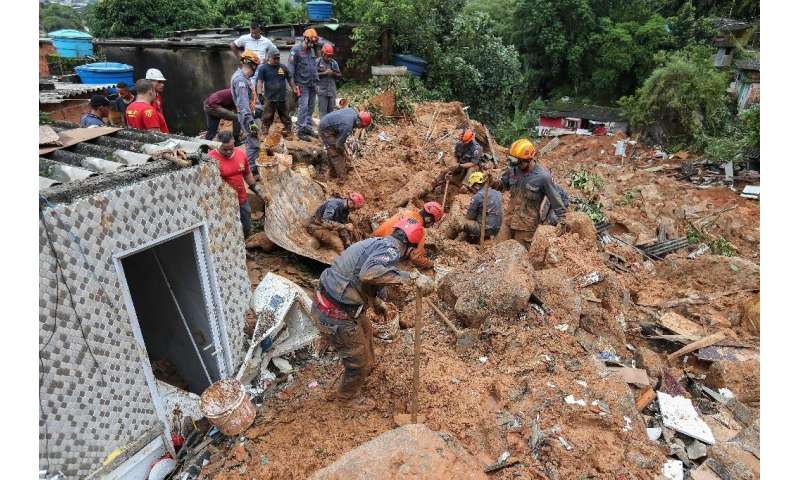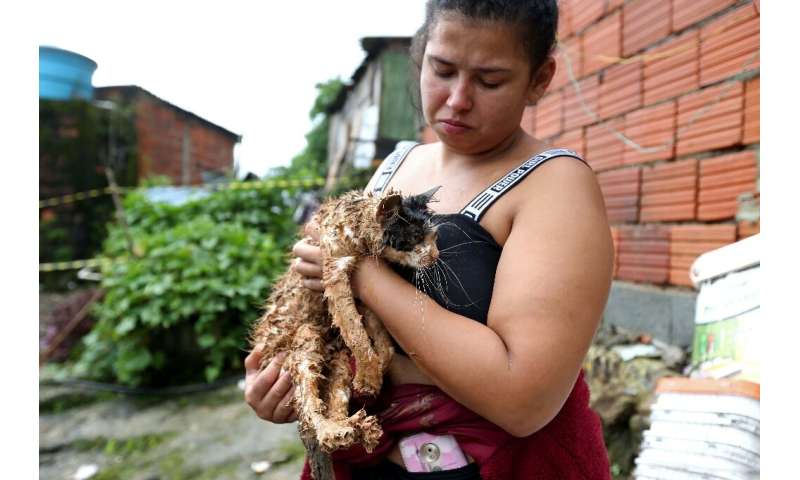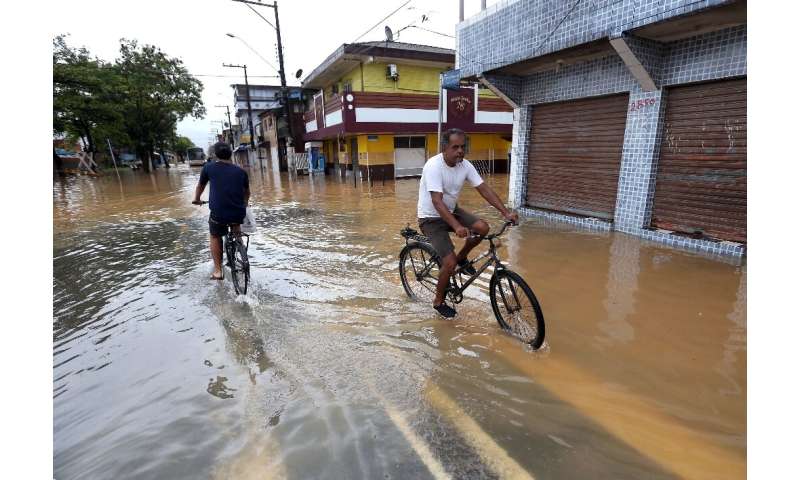by Paula Ramon

Rescuers search for victims at the Morro do Macaco Molhado favela in the coastal city of Guaruja, Sao Paulo, after it was struck by torrential rains
Violent rain has killed scores of people and forced thousands from their homes this year in Brazil's most populous states, a disaster experts blame on climate upheaval but also rampant urbanization.
Flash floods, landslides and other havoc wrought by torrential rain have killed at least 29 people in recent days in the states of Sao Paulo and Rio de Janeiro. Another 25 are missing.
That comes after more than 50 people were killed by heavy rain that devastated the state of Minas Gerais in January.
The same scenes of destruction have played out in all three southeastern states, together home to more than 83 million people: poor neighborhoods wiped out by tidal waves of brown mud; houses and cars swept away by flash floods; residents evacuated by boat and helicopter as their streets turn to gushing rivers.
More than three million people live in high-risk zones in Brazil's southeast, which has been hit by record rain this year—in some places, a month's worth in a matter of hours.
As dozens of rescue workers dug through the debris of wrecked houses for his missing mother, stepfather and sister-in-law, one of those affected, 24-year-old Yago de Sousa Nunes, voiced frustration that the authorities did not do more to protect the at-risk population.
"The city government knew this was a high-risk zone, they knew how much rain was going to fall this week, but they didn't do anything to evacuate people," he said alongside the ruins of the Barreira de Joao Guarda neighborhood, in the coastal city of Guaruja, Sao Paulo.

Violent rain has killed scores of people and forced thousands from their homes this year in Brazil's most populous states, a disaster experts blame on climate upheaval but also rampant urbanization.
Flash floods, landslides and other havoc wrought by torrential rain have killed at least 29 people in recent days in the states of Sao Paulo and Rio de Janeiro. Another 25 are missing.
That comes after more than 50 people were killed by heavy rain that devastated the state of Minas Gerais in January.
The same scenes of destruction have played out in all three southeastern states, together home to more than 83 million people: poor neighborhoods wiped out by tidal waves of brown mud; houses and cars swept away by flash floods; residents evacuated by boat and helicopter as their streets turn to gushing rivers.
More than three million people live in high-risk zones in Brazil's southeast, which has been hit by record rain this year—in some places, a month's worth in a matter of hours.
As dozens of rescue workers dug through the debris of wrecked houses for his missing mother, stepfather and sister-in-law, one of those affected, 24-year-old Yago de Sousa Nunes, voiced frustration that the authorities did not do more to protect the at-risk population.
"The city government knew this was a high-risk zone, they knew how much rain was going to fall this week, but they didn't do anything to evacuate people," he said alongside the ruins of the Barreira de Joao Guarda neighborhood, in the coastal city of Guaruja, Sao Paulo.

A cat rescued from a landslide in the Morro do Macaco Molhado favela in the coastal city of Guaruja, Sao Paulo
Extreme weather
Is climate change to blame?
Experts say more studies are needed to be sure.
But there is no doubt the region is experiencing "an increase in extreme weather events," said Andrea Ramos of the National Meteorological Institute.
This year, the rainy season in southeastern Brazil has been marked by extremes, said Marcelo Seluchi of the Natural Disaster Monitoring and Alert Center (Cemaden): very dry in the first half of the summer, then very wet from mid-January on.
"The planet is heating up, that's beyond doubt. It's more humid than 50 or 100 years ago, which means the same weather systems have more potential to create rain," he said.
That has combined with the rampant expansion of urban areas to increase people's vulnerability to floods.
Brazil's biggest cities have seen decades of nearly unchecked growth, as poor migrants arrive and settle wherever they can, often building unstable shantytowns on hillsides or the extreme city outskirts.
 A flooded street in the Morro do Macaco Molhado favela in Guaruja, in Brazil's Sao Paulo state
A flooded street in the Morro do Macaco Molhado favela in Guaruja, in Brazil's Sao Paulo state
"Population growth and the growth of cities means we're replacing vegetation with cement, and that's where a long-standing problem in Brazil comes into play: lots of building on high-risk areas," Seluchi told AFP.
More than half the population of the southeast region's state capitals—Sao Paulo, Rio de Janeiro, Belo Horizonte and Vitoria—lives in at-risk zones. And 80 percent of those people are "highly vulnerable: they live in very precarious houses, with high population density and a high percentage of children and the elderly," he said.
Housing problem
Rio de Janeiro's Mayor Marcelo Crivella, a far-right evangelical Christian bishop, caused outrage amid the floods when he blamed residents for the destruction.
"People like to live close (to flood-prone rivers and gulleys) because they spend less on sewage pipes for their pee and poop," he said.
Unaffordable housing costs have forced the urban poor into areas unfit for settlements, said Henrique Evers, an urban development expert at the World Resources Institute.

Extreme weather
Is climate change to blame?
Experts say more studies are needed to be sure.
But there is no doubt the region is experiencing "an increase in extreme weather events," said Andrea Ramos of the National Meteorological Institute.
This year, the rainy season in southeastern Brazil has been marked by extremes, said Marcelo Seluchi of the Natural Disaster Monitoring and Alert Center (Cemaden): very dry in the first half of the summer, then very wet from mid-January on.
"The planet is heating up, that's beyond doubt. It's more humid than 50 or 100 years ago, which means the same weather systems have more potential to create rain," he said.
That has combined with the rampant expansion of urban areas to increase people's vulnerability to floods.
Brazil's biggest cities have seen decades of nearly unchecked growth, as poor migrants arrive and settle wherever they can, often building unstable shantytowns on hillsides or the extreme city outskirts.
 A flooded street in the Morro do Macaco Molhado favela in Guaruja, in Brazil's Sao Paulo state
A flooded street in the Morro do Macaco Molhado favela in Guaruja, in Brazil's Sao Paulo state"Population growth and the growth of cities means we're replacing vegetation with cement, and that's where a long-standing problem in Brazil comes into play: lots of building on high-risk areas," Seluchi told AFP.
More than half the population of the southeast region's state capitals—Sao Paulo, Rio de Janeiro, Belo Horizonte and Vitoria—lives in at-risk zones. And 80 percent of those people are "highly vulnerable: they live in very precarious houses, with high population density and a high percentage of children and the elderly," he said.
Housing problem
Rio de Janeiro's Mayor Marcelo Crivella, a far-right evangelical Christian bishop, caused outrage amid the floods when he blamed residents for the destruction.
"People like to live close (to flood-prone rivers and gulleys) because they spend less on sewage pipes for their pee and poop," he said.
Unaffordable housing costs have forced the urban poor into areas unfit for settlements, said Henrique Evers, an urban development expert at the World Resources Institute.

Destruction caused by a landslide in the Morro do Macaco Molhado favela in Guaruja, in Brazil's Sao Paulo state
"Planning housing for vulnerable populations near urban services is one of the best ways to deal with this challenge," he said.
"Brazil still has a long way to go."
Explore further 21 dead as torrential rain hits Brazil
© 2020 AFP
"Planning housing for vulnerable populations near urban services is one of the best ways to deal with this challenge," he said.
"Brazil still has a long way to go."
Explore further 21 dead as torrential rain hits Brazil
© 2020 AFP
No comments:
Post a Comment